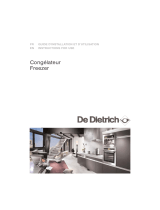
Congélation
Effectuez cette opération le plus hygiéniquement possible, étant donné que la congélation ne
stérilise pas les aliments. II est préférable de congeler les aliments en les subdivisant dans des
sacs, et en quantités consommables lors d’un seul repas. N’introduisez jamais d’aliments
chauds, ni même tièdes! Avant de mettre les aliments dans le congélateur, veillez à bien les
envelopper dans des sacs en plastique, dans des feuilles de polyéthylène ou d’aluminium ou
bien mettez-les dans des barquettes destinées à la congélation (ce matériel est en vente avec
l’étiquette “pour congélateur”). Chaque sac, chaque boîte, etc. que vous mettrez dans le
congélateur devra respecter les conditions suivantes:
• indication de la date de préparation et de la date de validité.
• le nombre de portions qui y sont contenues;
• les pots en verre devront être du type Pyrex et ils ne devront JAMAIS être entièrement
remplis (la congélation dilate les liquides);
• les sacs auront été comprimés afin d’en éliminer l’air à l’intérieur et ils devront être le plus
plats possible;
• chaque emballage, quelqu’il soit, devra être fermé de façon à bien protéger les aliments.
La plaque signalétique indique la quantité maximum des aliments que vous pouvez congeler
en 24 heures. N’y introduisez jamais une quantité supérieure. N’approchez pas les aliments
frais des aliments surgelés, afin de ne pas rehausser la température de ces derniers.
Les compartiments de congélation rapide sont les deux premiers en haut.
Attendez encore 24 heures avant de débrancher la congélation rapide. De toute façon la
congélation rapide se débranchera automatiquement après 48 heures.
Décongelez les produits seulement avant l'utilisation immédiate. La décongélation peut être
exécutée de quatre façons:
• dans le réfrigérateur;
• à température ambiante;
• dans un four traditionnel à 40/50° ou dans un four à micro-ondes;
• directement à la cuisson.
La décongélation dans le réfrigérateur est la plus lente mais la plus sûre et vous permet
d'économiser de l'énergie (le froid transmis durant la décongélation est cédé au réfrigérateur).
Nettoyage intérieur
H. Avant de commencer n'importe quelle opération il faut tout d'abord enlever la fiche de la
prise de courant. Effectuer le nettoyage de l’appareil en utilisant du bicarbonate de soude
dissout dans de l'eau ( 1 cuillère tous les 4 litres d'eau). NE PAS UTILISER DE PRODUITS
DETERGENTS ABRASIFS. Rincer avec de l'eau et essuyer à l'aide d' un chiffon. Brancher la
fiche dans la prise de courant.
Nettoyage extérieur
Avant de commencer toute opération, débranchez préalablement le congélateur. Pour le
nettoyage extérieure, répétez les mêmes opérations, toujours avec les mêmes précautions que
celles effectuées lors du nettoyage intérieur. N’oubliez pas de nettoyer, de temps en temps, le
condenseur situé derrière l’appareil. Pour cette opération, servez-vous d’un chiffon sec ou,
mieux encore, de l’aspirateur.
Remarques importantes
Si vous achetez des produits surgelés
vérifiez:
• qu’ils soient bien fermés ou
enveloppés, que l’emballage soit
intact et qu’ils n’aient pas été abîmés;
• qu’il n’y ait pas de gouttelettes
glacées (qui indiquent que le produit
a été partiellement décongelé);
• qu’ils indiquent bien la date de
préparation ainsi que les dates
correspondant aux différents modèles
de congélateurs (le votre est ****)
• qu’ils ne se soient pas, même
partiellement, décongelés
entre-temps.
Ne mangez pas les produits lorsqu’ils
sont à peine sortis du congélateur
(glaces, esquimaux, glaçons, etc.): la
température très froide à laquelle ils se
trouvent pourrait provoquer des
brûlures par le froid, spécialement sur
la langue. En cas de coupure de
courant prolongée, transférez les
aliments congelés dans un congélateur
qui marche. Même si les aliments ne
se sont que partiellement
décongelés, ils ne pourront être
recongelés qu’après avoir été
cuisinés.
7
Lorsque vous avez des aliments frais à congeler, vous devez tout d’abord vider le
compartiment de congélation rapide en mettant les produits congelés dans les compartiments
de conservation, puis régler à nouveau sur congélation rapide. 24 heures après, vous pouvez
disposer les aliments frais dans le compartiment de congélation rapide.
CONGÉLATION
DÉCONGÉLATION
NETTOYAGE




















